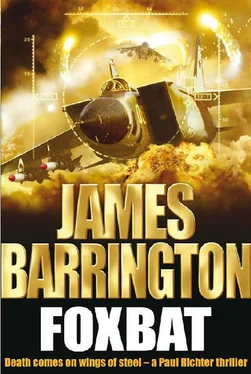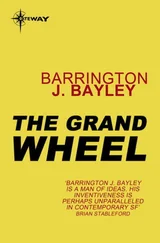USS Enterprise , North Pacific Ocean
‘Captain, sir, JTIDS is showing multiple launches from four North Korean airfields. Twenty… no, twenty-one contacts presently all heading north. This could be a first wave of bombers forming up to head across the DMZ.’
But in seconds the speed and rate of climb now being detected made it clear that the aircraft had to be fighters.
‘Heading north makes no sense, so once they get high enough they’ll turn south. Where are the British aircraft?’
‘Here, sir, over South Korea, due east of Ch’orwon. But won’t the Brits spot them on their radar?’
‘No, mister, they won’t, because some fuck-wit decided the new Harrier would work better without a radar. That means they’re blind up there. OK, contact the Hawkeye,’ Rodgers ordered. ‘Tell him to pull the Hornets out of their holding pattern and aim them towards – wait one – aim them at Kangnung. Keep them clear of territorial waters until we know for sure the gooks are intending to cross the DMZ. Get the Prowlers moving in that direction as well. And tell the Hawkeye to call the Harriers on Guard. Somebody needs to let them know what’s going on.’
Chiha-ri missile base, North Korea
Although he’d been expecting it, the sudden clatter of the teleprinter still took the commanding officer by surprise, and he hurried across his office to read the printed characters. At last . The telephone on his desk rang and he picked up the receiver. The caller didn’t identify himself, but there was no need.
‘You have received the order?’
‘Yes, sir.’
‘Good. Implement it immediately.’
The CO left the office, almost running down the stairs, and crossed into the missile preparation area. There, as he shouted orders, engines were started on three small but powerful tractors, and the HY-2 cruise missile trailers were towed out of the shelter to their pre-prepared positions. Once in place, the trailers were jacked up, using the tractors’ hydraulic systems, to form rigid platforms for the impending launch. Then the towing vehicles were unhitched and driven off.
The technicians were already waiting, and they plugged the power lines into shielded sockets next to the firing positions. The target coordinates had already been entered, so all that remained was to undertake a comprehensive systems check before the launch itself. This took under five minutes per missile and, less than ten minutes after they’d been towed out of the shelter, all three HY-2s were ready to fire.
The technical crews cleared the pad and retreated to launch control – a concrete bunker some one hundred metres distant – to carry out final communication checks with the cruise missiles. And then everything was ready.
The commanding officer glanced round the bunker, nodded his approval, and then uttered the single word: ‘Launch.’
On the concrete pads, the liquid-fuelled engines ignited almost simultaneously and, with a roar that seemed to shake the bunker, the three missiles leapt into the air, their paths diverging immediately.
MiG-25 Foxbat, callsign Zero Six, over North Korea
‘Zero Six, Chunghwa. All missiles have been fired. Detonation in approximately six minutes. Stand by to turn onto south.’
‘Zero Six.’
The North Korean plan was simple enough. The three HY-2s each carried a nuclear warhead, but the weapons weren’t aimed at any strategic targets to the south of the DMZ. Instead, each cruise missile had been programmed to fly across the Demilitarized Zone at low level, thus avoiding engagement, and perhaps even detection, by the Patriot batteries. Once well inside South Korea, the missiles would climb to high level where the warheads would detonate, hopefully simultaneously.
Their separation would ensure that the electromagnetic pulse the explosions generated would blanket the entire width of the Korean Peninsula along a line running east–west directly through Seoul. That, they hoped, would destroy every computer, radio, radar, communication system, and anything else that contained a memory chip or printed circuit, throughout the northern half of South Korea. Due to the fall-out, the explosions would probably also kill a large number of people, as might the blast itself, depending upon the altitude and yield of the devices, though nobody in Pyongyang cared about that.
But the North Koreans had a problem. In fact, they had two problems. The first was that cruise missiles are designed to fly horizontally at low level and fairly fast, which was ideal for avoiding the Patriot batteries, but the optimum detonation point for an EMP weapon is as high as possible. It’s been estimated that a high-yield device detonated over central North America at an altitude of about two hundred and fifty miles could affect every electrical circuit in the continental United States. Yet the maximum height Pyongyang had calculated the HY-2 could reach with its heavy warhead was only about twenty thousand feet.
The second difficulty was the yield. The power of the EMP is proportional to the prompt gamma-ray output, and in a fission explosion this equates to under four per cent of the total power of the device. This is substantially reduced by the high explosive used to initiate the detonation sequence, which can absorb as much as eighty-five per cent of the prompt gamma-rays. So for a ten-kiloton device – about the maximum power the scientists at Yongbyon had calculated their weapons would produce – the overall power of the EMP would be well below one per cent of the total yield. But that, they hoped, would still be enough.
The Foxbats were the insurance policy. They would hold north of the DMZ ready to take out any aircraft that the Americans or the South Koreans managed to launch. Then, with the American Patriot batteries blinded, their radars burnt out, and the CFC emasculated, the third stage of Pak Je-San’s plan would begin.
Cobra and Viper formation, over South Korea
‘Missile launch! Right two o’clock range about twenty miles. Two… no, three weapons.’ Roger Whittard’s voice was loud and excited.
‘My RAW’s not picking anything up,’ the Senior Pilot said, ‘but I see them too.’
‘They’re not SAMs,’ Richter said. ‘They’re cruise missiles. This looks like the opening salvo of North Korea’s invasion plan. The Patriots won’t be able to stop them, but maybe we can. Vipers, you take the one tracking south-west, which looks like it’s heading towards Seoul – and we’ll handle the other pair. I’ll hit the easterly one, OK, Splot?’
‘Roger that.’
Richter hauled his Harrier round in a tight descending port turn and pointed the nose almost straight down. Although the HY-2, like most cruise missiles, is subsonic, he knew he had a very limited window of opportunity to engage it. The missile was probably faster than his aircraft, so he had to plan the intercept carefully, and bring his Harrier in right behind it so that the Sidewinder could lock on. Once he’d released the missile, the ‘winder would certainly catch it: the weapon has a maximum speed of Mach 2.5.
The altimeter was unwinding at an alarming rate, the ground rushing towards him, but Richter wasn’t looking at his instruments, or even the HUD. His whole attention was focused on the scene out of the right-hand side of his cockpit, where a tiny grey dart, trailing a plume of smoke, was heading south-east at close to the speed of sound and very low. It looked to Richter as if it was less than five hundred feet above the ground, which wasn’t going to help him any.
Intercepting it would be difficult, he knew. That was one worry. The other was the Patriot batteries that studded the southern side of the DMZ. His Harrier was wearing a squawk issued by air traffic control at Seoul, but he couldn’t remember if the PAC-3 radar incorporated SSR identification. If it didn’t, his aircraft might be interpreted as an incoming ballistic missile, and it would really piss him off if he himself got shot down by the American or South Korean forces.
Читать дальше












